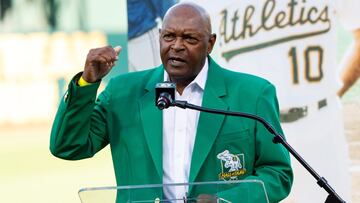How good was the legendary Oakland A’s pitcher Vida Blue who has passed away?
Both the Oakland A’s and the wider MLB community are in mourning today after the passing of one of the game’s absolute legends. He will be missed by all.


A member of the amazing Athletics team of the early 70s, and perhaps one of the greatest pitchers we’ve seen in many years, the A’s star will be remembered as much for his prowess on the field as his divisiveness off of it. That’s not to say that he didn’t do things the right way, rather he did them his way.
Oakland A’s legend Vida Blue passes away
MLB has been met with sad news today, with reports confirming that Vida Blue, a 17-year major leaguer and a key part of the dynastic Oakland Athletics during their famous World Series three-peat between 1972 and 1974, has died. He was 73-years-old.
A statement from the Oakland A's on the passing of Vida Blue. pic.twitter.com/fAMIU7MHCO
— Oakland A's (@Athletics) May 7, 2023
“There are few players with a more decorated career than Vida Blue,” the A’s said in a statement. “He was a three-time champion, an MVP, a six-time All-Star, a Cy Young Award winner, and an Oakland A’s Hall of Famer. Vida will always be a franchise legend and a friend. We send our deepest condolences to his family and friends during this arduous time.”
Taking stock of Vida Blue’s career
Born and raised in Louisiana, Blue was drafted by the then-Kansas City Athletics in the second round of the 1967 MLB draft. An obviously talented left-hander, the 19-year-old made his MLB debut in 1969 and just one year later threw a nine-strikeout no-hitter against the Minnesota Twins on September 21st. Indeed, the performance came as a punctuation point, following a one-hit showing just ten days earlier against the Kansas City Royals. By the time 1971 rolled around, Blue was well and truly a star. That season he pitched one of the best seasons in league history, with a record of 24-8. His ERA was 1.82 and his WHIP 0.95 across 312 innings. With 39 starts including 24 complete games, Blue earned himself an AL Cy Young award to go with an MVP one as well, meaning that at the tender age of 22, he became the youngest player to win the AL MVP in the 20th century.
Rest in peace, Vida 💚💛 pic.twitter.com/MXHRuRFfjH
— Oakland A's (@Athletics) May 7, 2023
Vida Blue’s contract dispute created an issue
While you might think that contractual disputes are a thing of the modern game, the reality is number crunching has always created problems. Back in 1972, a contractual dispute with A’s owner Charlie Finley saw Blue play just 25 games that season. To that extent, he was largely limited to bullpen work and was in fact the man on the mound when the A’s lost Game 6 of the World Series against the highly favored Cincinatti Reds that year. At any rate, the A’s would go on to win the series and Blue would post an impressive 2.57 ERA in 14 innings during the series.
Vida Blue has passed. May he RIP. The A’s were a powerhouse in the 70s under the helm of Charlie Finley. Finley tried to trade Vida Blue to the Yankees - only to have it voided by his nemesis Bowie Kuhn. Learn about it in a minute. #Athletics #SellTheTeam #Yankees #MLB #Redsox pic.twitter.com/aIwACJV2Dv
— Kelley Franco Throop (@threeinningfan) May 7, 2023
Truth be told, between 1971 and 1976 there was no better pitcher in the league. With an ERA of 2.72 and an average of 265 innings per season, Blue was both efficient and consistent. Even better, he was seemingly at his best during the post season. Who can forget his Game 5 save in the 1972 ALCS against the Detroit Tigers, or his two-hit shutout against the Baltimore Orioles in Game 3 of the 1974 ALCS? Yet, his relationship with Finley would prove to be an issue. In 1976, Blue infamously told reporters, “I hope the next breath Charlie Finley takes is his last. I hope he falls flat on his face and dies of polio.” It should come as no surprise, that Finley almost immediately tried to offload Blue to both the Yankees and the Reds, however, then commissioner Bowie Kuhn would have none of it.
The next chapter for Vida Blue was a mixed bag
Related stories
In 1978, Finley finally got his heart’s desire and with that Blue was traded to the San Francisco Giants in exchange for seven players. From 1978 to 1981 Blue spent his time trying to find form with the Giants and then from 1982 to 1983 he did the same with the Royals. What few knew, was that during those years he was struggling with severe drug addiction. Indeed, he missed the last two months of the 1983 season and the entirety of 1984′s due to the problem, before finally making a comeback of sorts in 1985 and 1986. Sadly, it was a battle that likely cost him Hall of Fame status, something he readily admitted to after spending four years on the ballot (1992-95). “I had some issues in my life that might have had a tendency to sway voting,” Blue said after failing to make the Hall of Fame ballot in 1995. “There are some guys in the Hall of Fame who don’t have halos.”
Love him or hate him, Vida Blue is a legend
When the curtain came down, Blue finished with a 209-161 record and a 3.27 ERA in over 3,300 innings between 1969 and 1986. A three-time 20-game winner and a five-time All-Star, Blue finished in the top seven of the Cy Young voting on five occasions and received MVP votes in four different seasons. There were also his three consecutive World Series championships with the A’s from 1972 to 1974. Interestingly, he was also the first pitcher to start the All-Star Game for both leagues - 1971 with the A’s and 1978 with the Giants - which only adds to his aura, as he was the last switch-hitter to win the AL MVP award. No official cause of death has been give, but what we can appreciate is that a legend has been lost. Following his playing career, Blue settled in San Francisco where he worked with a number of charities to promote baseball in inner city environments.

